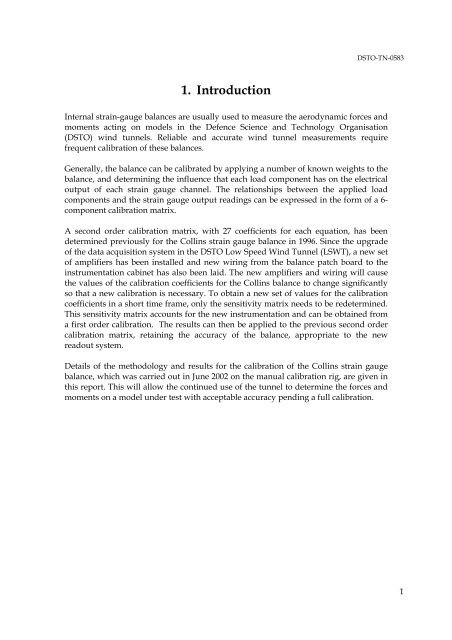Calibration for the Sensitivity Matrix of the Collins Strain Gauge ...
Calibration for the Sensitivity Matrix of the Collins Strain Gauge ...
Calibration for the Sensitivity Matrix of the Collins Strain Gauge ...
Create successful ePaper yourself
Turn your PDF publications into a flip-book with our unique Google optimized e-Paper software.
DSTO-TN-05831. IntroductionInternal strain-gauge balances are usually used to measure <strong>the</strong> aerodynamic <strong>for</strong>ces andmoments acting on models in <strong>the</strong> Defence Science and Technology Organisation(DSTO) wind tunnels. Reliable and accurate wind tunnel measurements requirefrequent calibration <strong>of</strong> <strong>the</strong>se balances.Generally, <strong>the</strong> balance can be calibrated by applying a number <strong>of</strong> known weights to <strong>the</strong>balance, and determining <strong>the</strong> influence that each load component has on <strong>the</strong> electricaloutput <strong>of</strong> each strain gauge channel. The relationships between <strong>the</strong> applied loadcomponents and <strong>the</strong> strain gauge output readings can be expressed in <strong>the</strong> <strong>for</strong>m <strong>of</strong> a 6-component calibration matrix.A second order calibration matrix, with 27 coefficients <strong>for</strong> each equation, has beendetermined previously <strong>for</strong> <strong>the</strong> <strong>Collins</strong> strain gauge balance in 1996. Since <strong>the</strong> upgrade<strong>of</strong> <strong>the</strong> data acquisition system in <strong>the</strong> DSTO Low Speed Wind Tunnel (LSWT), a new set<strong>of</strong> amplifiers has been installed and new wiring from <strong>the</strong> balance patch board to <strong>the</strong>instrumentation cabinet has also been laid. The new amplifiers and wiring will cause<strong>the</strong> values <strong>of</strong> <strong>the</strong> calibration coefficients <strong>for</strong> <strong>the</strong> <strong>Collins</strong> balance to change significantlyso that a new calibration is necessary. To obtain a new set <strong>of</strong> values <strong>for</strong> <strong>the</strong> calibrationcoefficients in a short time frame, only <strong>the</strong> sensitivity matrix needs to be redetermined.This sensitivity matrix accounts <strong>for</strong> <strong>the</strong> new instrumentation and can be obtained froma first order calibration. The results can <strong>the</strong>n be applied to <strong>the</strong> previous second ordercalibration matrix, retaining <strong>the</strong> accuracy <strong>of</strong> <strong>the</strong> balance, appropriate to <strong>the</strong> newreadout system.Details <strong>of</strong> <strong>the</strong> methodology and results <strong>for</strong> <strong>the</strong> calibration <strong>of</strong> <strong>the</strong> <strong>Collins</strong> strain gaugebalance, which was carried out in June 2002 on <strong>the</strong> manual calibration rig, are given inthis report. This will allow <strong>the</strong> continued use <strong>of</strong> <strong>the</strong> tunnel to determine <strong>the</strong> <strong>for</strong>ces andmoments on a model under test with acceptable accuracy pending a full calibration.1
















